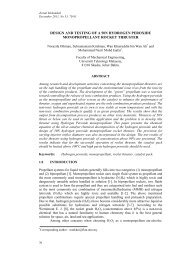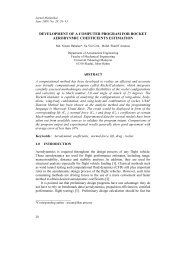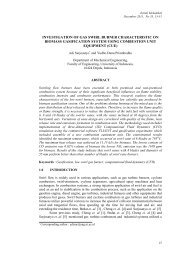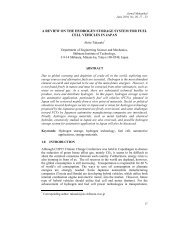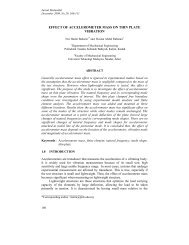FLOW BEHAVIOUR AROUND WINGLETS - Jurnal Mekanikal
FLOW BEHAVIOUR AROUND WINGLETS - Jurnal Mekanikal
FLOW BEHAVIOUR AROUND WINGLETS - Jurnal Mekanikal
Create successful ePaper yourself
Turn your PDF publications into a flip-book with our unique Google optimized e-Paper software.
<strong>Jurnal</strong> <strong>Mekanikal</strong>, June 2012The side forces reduce the inflow above the wing at the tip, and the outflow below thewing at the tip. The reduction in the inflow and outflow help to normalize the liftdistribution along the entire span of the wing, just as a wing with a higher aspect ratio willhave a more even lift distribution [5]. This study was conducted using two methods, theexperimental method, using PIV and the numerical analysis using FLUENT.2.0 LITERATURE STUDYWinglets belong to the class of wingtip devices aimed to reduce induced drag. Selectionof the wingtip device depends on the specific situation and the airplane model. In the caseof winglets, the reduction of the induced drag is accomplished by acting like a small sailwhose lift component generates a traction force, draining energy from the tip vortices [6].Studies concerning the efforts to decrease the fuel consumptions and loweremissions are the interest of the aviation industry, especially in the era of rising fuelprices and environmental issues. These researches are into a device that will providelonger range and more resourceful fuel consumption rates especially to commercialaircraft. It was found that there are two wingtip devices that will provide better fuelconsumption rates and could provide longer range, which are the winglets and the rakedwingtips [1].There is seven percent increase of the aircraft’s range at cruise conditions (fullspeed conditions) for aircrafts with wings designed with winglet compared to wingwithout winglets. Other than that, wing with winglets or wingtip devices on commercialaircraft are found to have lower wing loading and better fuel consumption rates. All theadvantages of the winglets and raked wingtip performances are due to its ability to reducethe induced drag, or the drag generated during take-off by a 3-dimensional finite wing [1].The induced drag, or the drag generated during take-off is due to the difference inpressure of the upper and lower surfaces of an aircraft wings. The high pressure part is onthe lower surface of the wing while the lower pressure part is located on the upper surfaceof the wing. The difference in pressure on the wing will form a net lifting force that isnormal to the free stream airflow [1]. The difference of pressure on a clean wing, (a wingwith no wingtip devices), will cause air to flow from the lower surface to the uppersurface of the wing at the wingtips. The flow of air from the lower surface of the wing tothe upper surface of the wing at the wingtips produces a downwash onto the top of thewing, as illustrated in Figure 1:Figure 1: Pressure distribution on a wingDrag is caused by the induced drag that is created by the downwash of airflowonto the upper surface of the wing at the wingtips thus producing vortices that trail in theaircraft’s wake. The most important wingtip devise’s functions is reduce the induced dragand consequently, the trailing vortex strength. By minimizing the induced drag, and thusthe wingtip vortices produced by an aircraft’s wing, the energy required to create the tipvortices can be conserved and the total drag on the wing reduced. The coefficient for theinduced drag over a 3-D wing (C Di ) is given by:96



